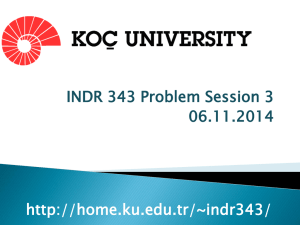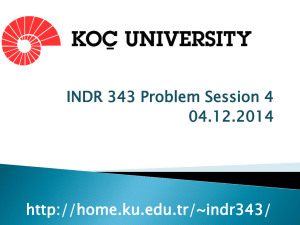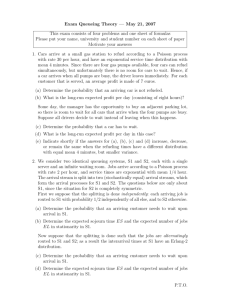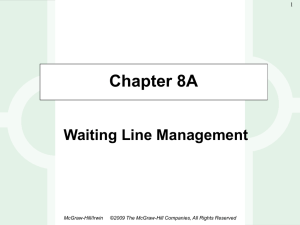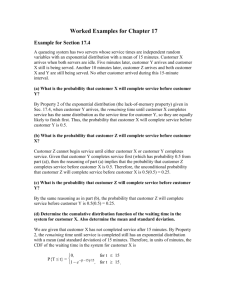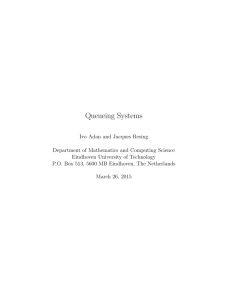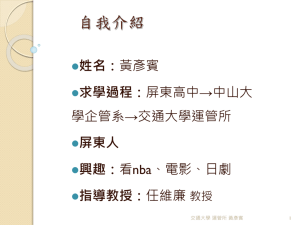元智大學91-91(M/M/1/4)
advertisement
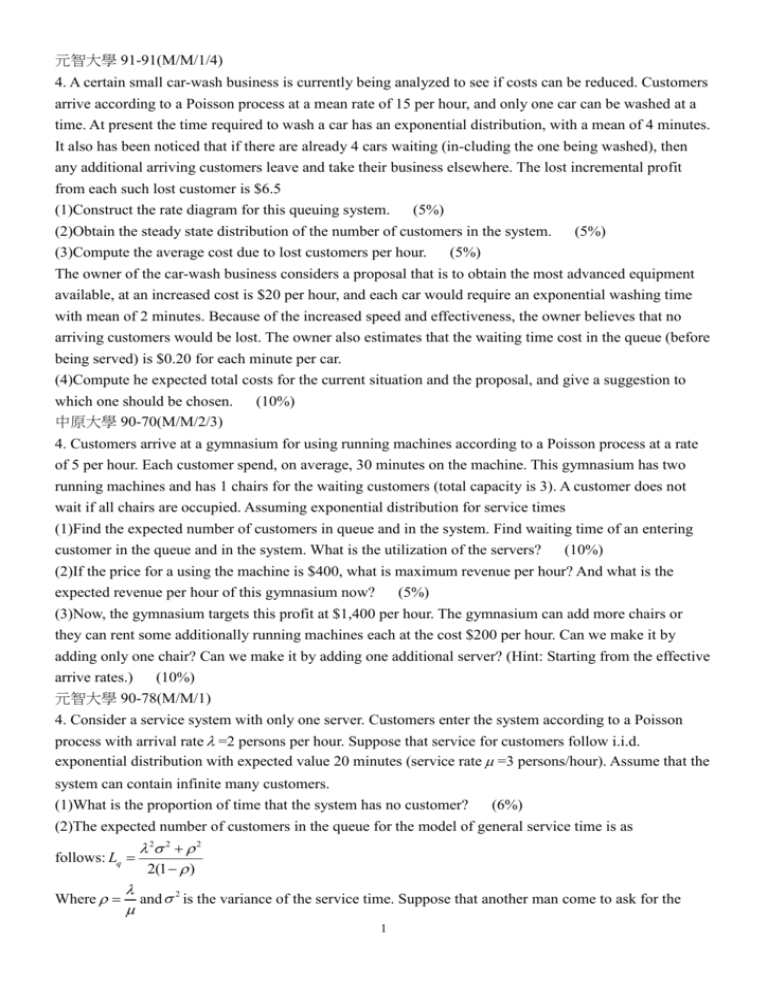
元智大學 91-91(M/M/1/4) 4. A certain small car-wash business is currently being analyzed to see if costs can be reduced. Customers arrive according to a Poisson process at a mean rate of 15 per hour, and only one car can be washed at a time. At present the time required to wash a car has an exponential distribution, with a mean of 4 minutes. It also has been noticed that if there are already 4 cars waiting (in-cluding the one being washed), then any additional arriving customers leave and take their business elsewhere. The lost incremental profit from each such lost customer is $6.5 (1)Construct the rate diagram for this queuing system. (5%) (2)Obtain the steady state distribution of the number of customers in the system. (5%) (3)Compute the average cost due to lost customers per hour. (5%) The owner of the car-wash business considers a proposal that is to obtain the most advanced equipment available, at an increased cost is $20 per hour, and each car would require an exponential washing time with mean of 2 minutes. Because of the increased speed and effectiveness, the owner believes that no arriving customers would be lost. The owner also estimates that the waiting time cost in the queue (before being served) is $0.20 for each minute per car. (4)Compute he expected total costs for the current situation and the proposal, and give a suggestion to which one should be chosen. 中原大學 90-70(M/M/2/3) (10%) 4. Customers arrive at a gymnasium for using running machines according to a Poisson process at a rate of 5 per hour. Each customer spend, on average, 30 minutes on the machine. This gymnasium has two running machines and has 1 chairs for the waiting customers (total capacity is 3). A customer does not wait if all chairs are occupied. Assuming exponential distribution for service times (1)Find the expected number of customers in queue and in the system. Find waiting time of an entering customer in the queue and in the system. What is the utilization of the servers? (10%) (2)If the price for a using the machine is $400, what is maximum revenue per hour? And what is the expected revenue per hour of this gymnasium now? (5%) (3)Now, the gymnasium targets this profit at $1,400 per hour. The gymnasium can add more chairs or they can rent some additionally running machines each at the cost $200 per hour. Can we make it by adding only one chair? Can we make it by adding one additional server? (Hint: Starting from the effective arrive rates.) (10%) 元智大學 90-78(M/M/1) 4. Consider a service system with only one server. Customers enter the system according to a Poisson process with arrival rate =2 persons per hour. Suppose that service for customers follow i.i.d. exponential distribution with expected value 20 minutes (service rate =3 persons/hour). Assume that the system can contain infinite many customers. (1)What is the proportion of time that the system has no customer? (6%) (2)The expected number of customers in the queue for the model of general service time is as follows: Lq Where 2 2 2 2(1 ) and 2 is the variance of the service time. Suppose that another man come to ask for the 1 service job. His service time is distributed as follow: Pr T 10 minutes Pr T 20 minutes Pr T 30 minutes 1 3 What is the expected waiting time in the queue if this person is hired as service man. Is this person better than the one with exponential service time with mean service rate =3 persons/hour? Why? (7%) (3)Suppose that the system can contain at most two persons (including the one being served ) and the service time is exponentially distributed with service rate =3 persons/hour. What is the expected number of customers in the system when the system reaches the steady state? What is the expected waiting time in the system for a customer when the system reaches the steady state? What is the fraction of customers getting lost in the long run? (12%) 台灣科技大學 92-39(M/M/1) 2. A company is trying to determine whether to rent a slow or a fast fax machine. The company believes that an employee’s time is worth $15 per hour. The slow machine rents for $4 per hour, and it takes an employee an average of 10 minutes to complete sending (exponentially distributed). The fast machine rents for $15 per hour and it takes an employee of 6 minutes to complete sending. An average of 4 employees per hour need to use the fax machine (interarrival times are exponential). Which machine should the company rent? (25%) 台北科技大學 92-54(finite) 4. Customers randomly arrive to a small hamburger stand with one server at the rate of 24 per hour. However, if there are n customers already there, a fraction n/3 of the arriving customers goes elsewhere. Customers are served first-come, first serve according to an exponential distribution with a mean service time of 3 minute. (20%) (1)What is the maximum number of customers in the system? (including those waiting on line and the one in the one being served.) (2%) (2)What is the percentage of no one in the system? (2%) (3)If each customer requires 10 square feet of counter space, what is the minimum counter space that must be provided to accommodate all customers at the stand at lease 70 percent of the time? (8%) (4)On the average, how many customers are waiting on the line? (8%) 交通大學 94-14(finite) 6. A convenience store has two cashiers. Customers arrive according to a Poisson process at a mean rate of 20 customers per hour. However, if the two cashiers already are busy, these potential customers may balk (go on to another store). In particular, if there are n( 2) customers already in the store, the probability that an arriving potential customer will balk is n/4 for n=2,3,4. For example, when n=3 , the mean arrival rate will reduce to 12(1-3/4)=3. The time each cashier to service a customer has an exponential distribution with a mean of 7.5 minutes (or 8 customers per hour). (1)Construct the rate diagram for this queueing system. (5%) (2)Develop the balance equations. (7%) (3)Solve these equations to find the steady-state probability distribution of the number of customers in the store. (8%) 台灣課技大學 94-65(B&D) 5. Consider a one-server queueing system in which the arrival and service rates are given by 2 n 10 n, n 0,1, 2,3 n 5 (1)Set up the rate diagram and determine the balance equations for the system. (2)Determine the steady-state probabilities. (15%) 台灣科技大學 93-54(M/M/3) n 5, n 1, 2,3, 4 (10%) 3. The manager of a large group of employees must decide if she needs another photocopying machine. The cost of renting a machine is $40 per 8-hour day whether or not the machine is in use. An average of 4 people per hour need to use the copying machine. Each person uses the copying machine for an average of 10 minutes. Interarrival times and copying times are exponent-tially distributed. Employees ate paid $8 per hour, and assume that a waiting cost is incurred when a worker is waiting in line or is using the copying machine. How many copying machines should be rented? 清華大學 92-27(M/M/S,M/M/2K) 5. Construct the transition diagram and then (b) write the balanced equation of the following queueing systems; (1)M/M/s (2)M/M/2/K 中央大學 92-37(M/M/4M4,M/M/∞) 5. A small parking lot in front a fast food restaurant has four parking spaces. A cat that arrives finding parking space full will go away and never come back. The arrival process of the cars is a Poisson process with rate 20 per hour and each car occupies a parking space for an exponential time with mean 5 minutes. We would like to analyze the system by using queueing model. (1)What is the loss probability of an arrival? What is effective arrival rate? (10%) (2)What is the average number of occupied parking spaces? What is the utilization of each parking space? (10%) (3)The whole parking space is rented by this restaurant and this restaurant has to pay park fee $40 per hour per car and each car will spend $200 for food. What is the total income for this restaurant per hour? (10%) 清華大學 92-28(Birth & Death) 6. Consider the birth and death process with birth rates b 2, 1 =3, 2 =2, 3 =1, & n =0n>3 and death rates 1 =3, 2 =4, 3 =1 & n =2n>3 (1)Construct its transition diagram. (2)Write its balanced equations. (3)Solve the steady-state probability Pnn 0,1, 2,3, (4)Calculate L and W 清華大學 92-25(Finite population) 4. Suppose there are N identical & independent machines and one repairman, the time to failure of each machine is exponential with rate and the repair time of each machine is exponential with rate .Please describe the following; (1)What queuing system used will be appropriate to determine the average waiting length for repair? 3 (2)Construct the corresponding transition diagram for the queueing system. (3)Write the balance equations (4)Solve the steady-state probability Pnn 0,1, 2,3, (5)Calculate queueing length L and system waiting time W (6)Describe the relation between L and W 台北科技大學 93-65(3 個 M/M/1 and M/M/3) 5. A three teller bank is experiencing long queues during certain peak periods. A study has shown that customer service takes an average of 3 minutes and follows the exponential distribution. An average of 45 customers per hour arrive at the band and randomly join one of the three individual teller queues. (20%) (1)On the average how long are the customers waiting in the queues and how many customers are waiting for service? (2)How would the average queueing time and queue length change if a single (pooled)queue strategy were implemented? 成功大學 93-50(Birth & Death) 6. An airlines reservation system has two computers, one on-line and one backup. The operating computer fails after an exponentially distributed duration having rate and is replaced by the standby. There is one repair facility, and repair times are exponentially distributed with rate . (1)Model this system as a Markov Chain (2)What is the probability that the reservation system is down? 成功大學 93-51(Birth & Death) (20%) 7. Consider M/M/S queuing system, show that (10%) S 1 S 1 n 0 n 0 L nPn Lq S (1 Pn ) Where L is the expected number of customers in system, Lq is the expected number of customers in queue, and Pn is the probability with n customers in system. 中央大學 93-34(General Queuing Birth & Death) 3. Consider a taxi station where taxis looking for passengers, taxis arrive according to Poisson process with rate 1 per minute and passengers arrive according to Poisson process with rate 1.25 per minute. A taxi will wait no matter how many other taxis are in line; but an arriving passenger waits only if the number of passengers already waiting for taxis is three or less. Assuming steady-state conditions, (1)Define the state for this problem. (5%) (2)Draw the transition diagram and compute the steady-state probability for each state. (8%) (3)Find the expected number of taxis waiting for passengers. (7%) (4)Find the expected number of passengers waiting for taxis. (5%) 交通大學 93-10(M/M/∞) 1. Consider a self-service model in which the customer is also the server. Note that this corresponds to having an infinite number of servers available. Customers arrive according to a Poisson process with parameter , and service times have an exponential distribution with parameter . (16%) 4 (1)Find Lq , and Wq . (3%) (2)Construct the rate diagram for this queueing system. (3%) (3)Use the balance equations to find the expression for Pn in terms of P0 . (4)Find P0 . (3%) (3%) (5)Find L and W. (4%) 台灣科技大學 94-65(Birth & Death) 5. Consider a one-server queueing system in which the arrival and service rates are given by n 10 n, n 0,1, 2,3 n 2 (1)set up the rate diagram and determine the balance equations for the system. (2)Determine the steady-state probabilities. (15%) 清華大學 94-37(M/M/1) n 5, n 1, 2,3, 4 (10%) 2. (1)Consider the following one-step transition matrix of a Markov chain (with states 0,1,2,3,4). (10%) states 0 1 2 3 4 0 1 4 1 3 4 1 2 3 30 4 0 0 0 0 0 0 1 0 0 3 0 0 3 1 4 4 1 3 0 0 4 4 Determine the classes of the Markov chain and whether they are recurrent. 3 4 1 4 1 3 0 (2)Consider an M/M/1 system with mean arrival rate and service rate Given P Wq t for t 0 . (必須有推導過程,提示 P W t e u (1* p ) , p , t 0 .) t 交通大學 94-33(General M/M/2) 7. A department has one word-processing operator. Documents produced in the department are delivered for word processing according to a Poisson process with an expected interarrival time of 20 minutes. When the operator has just one document to process, the expected service times is 15 minutes. When she has more than one document, then editing assistance that is available reduces the expected service time for each document to 10 minutes. In both cases, the service times have an exponential distribution. (1)Construct the rate diagram for this queneing system. (2%) (2)Find P0 , P1 and Pn . (6%) (3)Derive L for the system. (5%) 5 (4)Find Lq , and Wq . (4%) 交通大學 94-14(Finite Population) 6. A convenience store has two cashiers. Customers arrive according to a Poisson process at a mean rate of 20 customers per hour. However, if the two cashiers already are busy, these potential customers may balk (go on to another store).In particular, if there are n( 2) customers already in the store, the probability that an arriving potential customer will balk is n/4 for n=2,3,4. For example, when n=3, the mean arrival rate will reduce to 12(1-3/4) =3. The time each cashier to service a customer has an exponential distribution with a mean of 7.5 minutes (or 8 customers per hour). (1)Construct the rate diagram for this queueing system. (5%)j (2)Develop the balance equations. (7%) (3)Solve these equations to fing the steaky-state probability distribution of the number of customers in the store. (8%) 6
